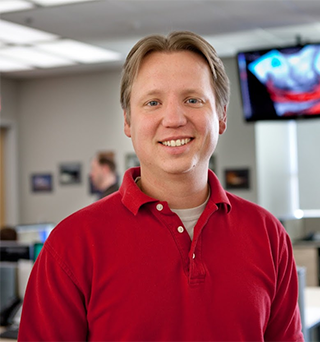 |
NOAA’s Weather-Ready Nation is about building community resilience in the face of increasing vulnerability to extreme weather and water events.
The People of Weather-Ready Nation is an interview series that sits down with some of the people responsible for building a Weather-Ready Nation. We recently talked to Dr. Adam Clark, Research Scientist, Cooperative Institute for Mesoscale Meteorological Studies at the National Severe Storms Laboratory.
1. What does a Weather-Ready Nation mean to you?
I view Weather-Ready Nation as creating communities better prepared for any type of weather event that will impact people's lives. Impacts could range from the mundane – for example, knowing whether storms will ruin an afternoon sporting event or cause a flight delay – to the extreme, for example, impacts from tornadoes, wildfires, flash floods, and hurricanes. Becoming more "weather ready" involves improving the forecast models used to predict weather, as well as improving the communication of weather information to the wide range of end users and communities.
2. How are you helping to build a Weather-Ready Nation?
A large portion of my research emanates from activities conducted as part of the NOAA/Hazardous Weather Testbed Spring Forecasting Experiment, for which I am a lead planner and facilitator. The annual experiment is a collaborative five-week long effort between scientists and operational forecasters at NOAA's Storm Prediction Center (SPC) and National Severe Storms Laboratory. During the experiment, new and innovative severe weather prediction tools are tested in a simulated forecasting environment – if the tools are found useful they eventually get implemented for use by operational severe weather forecasters. Thus, this work impacts a wide range of people of that rely on SPC for forecasts of severe weather.
3. What is the biggest challenge you see in making the nation ready, responsive, and resilient to extreme events.
The biggest challenge for a Weather-Ready Nation is generating accurate and reliable probabilistic weather information for a wide range of time scales and weather phenomenon, and then communicating this information to the public in an understandable and actionable way. These goals are especially challenging because they involve collaboration between multiple disciplines including operational forecasters, research meteorologists, and social scientists. As a society to become weather-ready it helps to always be "weather aware", to know the types of severe weather your particular region is susceptible to, and to have plans of action for those types of severe weather.
About:
Dr. Clark is a research scientist for the Cooperative Institute for Mesoscale Meteorological Studies at the National Severe Storms Laboratory and is one of the lead planners and facilitators for the annual NOAA/Hazardous Weather Testbed Spring Forecasting Experiments. His primary research interests are geared towards developing weather model diagnostics, verification, and visualization strategies for high resolution ensemble forecasts, as well as exploring model physics sensitivities and predictability at convective scales. Dr. Clark served as a National Research Council post-doc for NSSL from 2009 to 2011 and received his BS, MS, and PhD from Iowa State University.